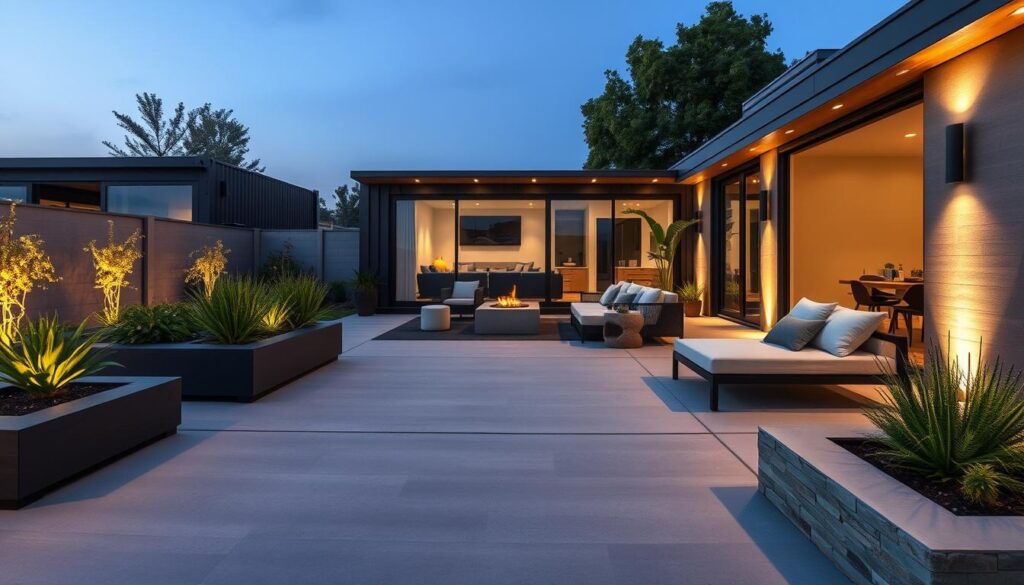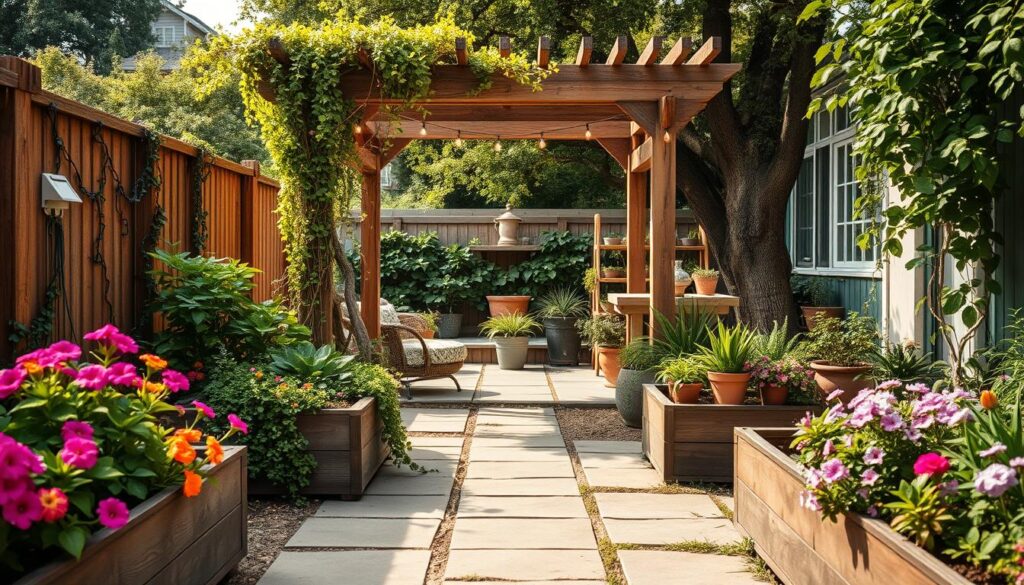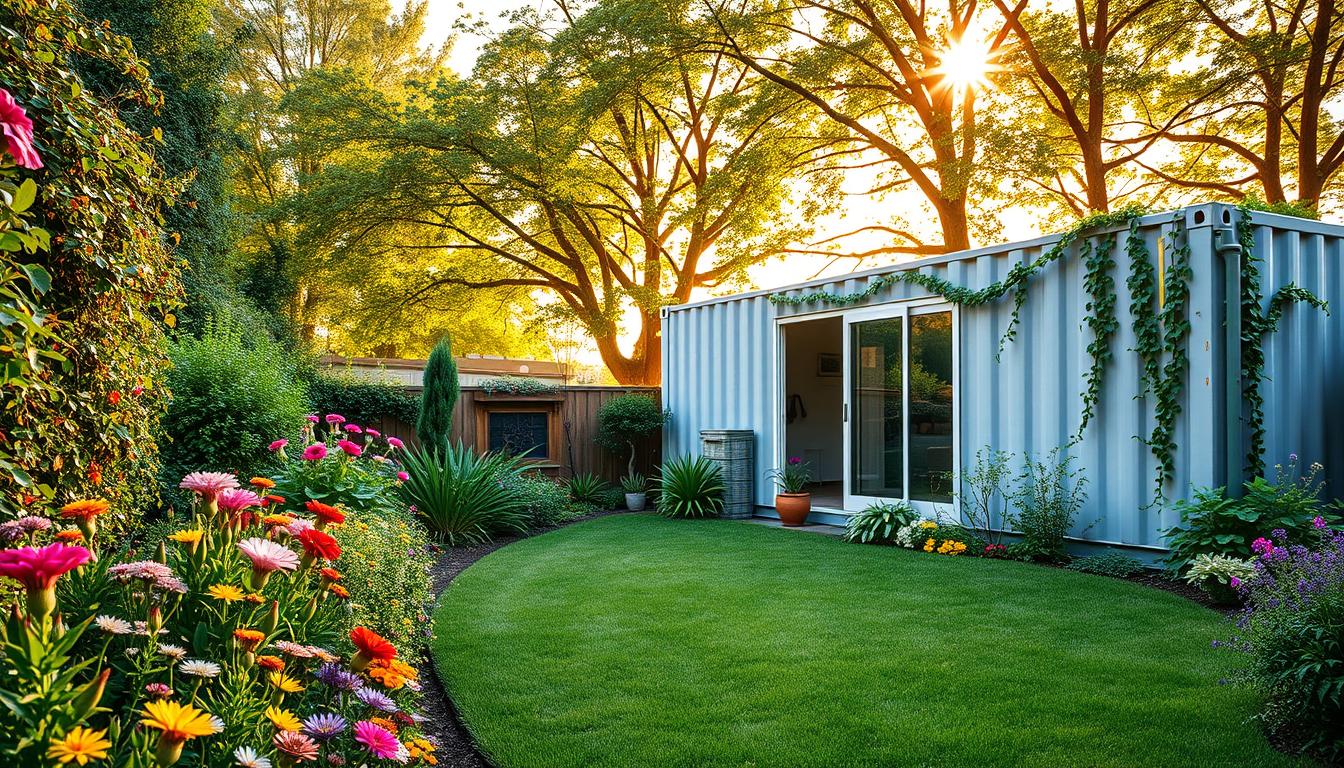Shipping container homes have gained popularity for their unique aesthetic and functional benefits. According to Cedreo, professionals can maximize space and inspire creativity by incorporating innovative landscaping ideas around these structures.
These homes offer a blank canvas for homeowners to express their style, from modern minimalist designs to more elaborate outdoor spaces. Effective container home landscaping ideas can enhance the curb appeal and create a seamless transition between the home and its surroundings.
The challenge lies in balancing the industrial look of shipping containers with natural elements. By doing so, homeowners can create a harmonious and inviting outdoor space that complements their unique home.
Key Takeaways
- Shipping container homes provide a unique opportunity for creative landscaping.
- Incorporating natural elements can enhance the curb appeal.
- Effective landscaping can create a seamless transition between the home and its surroundings.
- Balancing industrial and natural elements is key to a harmonious outdoor space.
- Innovative landscaping ideas can maximize space and inspire creativity.
Understanding the Unique Landscape Needs of Container Homes
Shipping container homes present a unique set of challenges and opportunities for landscaping. Their distinct dimensions and industrial aesthetic require careful planning to create inviting and comfortable living areas.
The architectural constraints of container homes, such as limited space and a rectangular footprint, can be turned into opportunities with thoughtful design. For instance, vertical gardening can maximize space, while the industrial look can be softened with natural elements.
The Architectural Constraints and Opportunities
Container homes have specific dimensions that necessitate creative landscaping solutions. By embracing these constraints, homeowners can create unique outdoor spaces that complement the home’s architecture.
Balancing Industrial Aesthetics with Natural Elements
To balance the industrial look of container homes, incorporating natural elements such as plants, wood, and stone is essential. This blend of materials can create a harmonious and welcoming outdoor environment.
| Landscaping Element | Industrial Aesthetic | Natural Elements |
|---|---|---|
| Materials | Metal, Concrete | Wood, Stone, Plants |
| Design Approach | Modern, Minimalist | Organic, Curved Lines |
Climate Considerations for Container Home Landscapes
Climate plays a crucial role in landscape design for container homes. Understanding local climate conditions can help homeowners choose drought-tolerant plants or implement rainwater harvesting systems, enhancing the eco-friendliness of their landscaping.
Low-Maintenance Landscaping for a Shipping Container Home: Core Principles
Low-maintenance landscaping is a must for shipping container homes, offering a perfect blend of aesthetics and functionality. To achieve an effortless outdoor space, it’s essential to focus on core principles that simplify upkeep while enhancing the home’s unique architecture.
Designing with Minimal Upkeep in Mind
Designing with minimal upkeep in mind involves selecting plants and materials that require less care. Easy-care landscaping starts with choosing low-maintenance plants that thrive in the local climate, reducing the need for frequent watering, pruning, or fertilizing. Incorporating groundcovers, succulents, and native plants can significantly minimize maintenance efforts.
Water Conservation Strategies
Water conservation is a critical aspect of low-maintenance landscaping. Implementing drought-tolerant plants and efficient irrigation systems, such as drip irrigation, can significantly reduce water consumption. Additionally, collecting rainwater in barrels for irrigation purposes is a sustainable practice that lowers water bills and supports the local ecosystem.
Space-Efficient Planning Techniques
Space-efficient planning is vital for shipping container homes, which often have limited outdoor space. Utilizing vertical gardening techniques, such as trellises or wall-mounted planters, can maximize space while adding visual interest. Compact or dwarf varieties of plants are also ideal for small landscapes, providing the desired aesthetic without overwhelming the space.
By incorporating these core principles, homeowners can create a beautiful, functional outdoor space that complements their shipping container home without demanding excessive maintenance. The key is to strike a balance between aesthetics, functionality, and sustainability.
Drought-Tolerant Plants Perfect for Container Home Settings
For those embracing the container home lifestyle, selecting the right plants can make all the difference in sustainability. Drought-tolerant plants are not only water-efficient but also add a unique aesthetic to your landscape.
Native Succulents and Cacti Options
Native succulents and cacti are excellent choices for container home landscapes due to their hardiness and minimal water requirements. Succulents like aloe vera and agave are not only drought-tolerant but also offer medicinal benefits and architectural interest.
Ornamental Grasses That Thrive with Minimal Care
Ornamental grasses are another great option, providing movement and texture to your landscape. Pampas grass and blue oat grass are popular choices that require minimal upkeep and can thrive in various climates.
Perennial Flowers for Year-Round Color
Perennial flowers can add vibrant colors to your landscape throughout the year. The choice between warm and cool climate selections depends on your location.
Warm Climate Selections
In warmer climates, consider plants like lantana and zinnias, which are not only drought-tolerant but also attract pollinators.
- Lantana
- Zinnias
- Hibiscus
Cool Climate Selections
For cooler climates, coneflowers and black-eyed susans are excellent choices, offering hardiness and beauty with minimal care.
- Coneflowers
- Black-eyed Susans
- Lupines
By incorporating these drought-tolerant plants into your container home landscape, you can achieve a beautiful, sustainable outdoor space that thrives with minimal maintenance.
Hardscaping Elements That Complement Container Architecture
Hardscaping plays a pivotal role in transforming the area around a container home into an inviting outdoor living space. By incorporating the right elements, homeowners can enhance the aesthetic appeal and functionality of their property.
Gravel and Stone Pathways
Gravel and stone pathways are popular choices for container homes due to their low maintenance and versatility. They can be used to create meandering paths that guide visitors through the landscape, adding visual interest and texture.
Benefits of Gravel and Stone Pathways:
- Low maintenance
- Cost-effective
- Variety of styles and materials available
Concrete Features and Modern Pavers
Concrete features and modern pavers offer a sleek, contemporary look that complements the industrial aesthetic of container homes. They can be used for patios, walkways, and other hardscaping elements.
Considerations for Concrete Features:
| Feature | Benefits | Considerations |
|---|---|---|
| Stamped Concrete | Customizable patterns, durable | Can be expensive, requires sealing |
| Modern Pavers | Versatile, easy to repair | May shift over time, requires sand base |
Metal Accents That Echo Container Materials
Metal accents can be used to create a cohesive look between the container home and its surroundings. Materials like corten steel and aluminum can add an industrial touch.
Wooden Decking and Platform Options
Wooden decking and platforms provide a warm contrast to the industrial feel of container homes. They can be used to create inviting outdoor spaces for relaxation and entertainment.

Vertical Gardening Solutions for Limited Spaces
Vertical gardening is a game-changer for shipping container homes, offering a practical and visually appealing solution for maximizing limited spaces. By utilizing vertical surfaces, homeowners can create lush, green areas that not only enhance the aesthetic appeal of their property but also contribute to a healthier environment.
Container Walls as Growing Surfaces
One of the most innovative ways to implement vertical gardening is by using container walls as growing surfaces. This involves attaching planters or pockets to the exterior walls of the container home, creating a living wall that adds texture and color to the space.
To implement this, you can use a variety of materials such as wooden trellises, metal grids, or even recycled plastic planters. The key is to select plants that thrive in vertical conditions and require minimal maintenance.
Benefits of Container Walls as Growing Surfaces:
- Maximizes space
- Enhances aesthetic appeal
- Improves air quality
Freestanding Vertical Garden Structures
For those who prefer not to alter their container home’s exterior, freestanding vertical garden structures offer an excellent alternative. These structures can be placed strategically around the property, providing a flexible and movable gardening solution.
Freestanding vertical gardens can be made from a variety of materials, including wood, metal, and recycled materials. They come in different designs, from simple trellises to complex modular systems.
| Type | Material | Maintenance Level |
|---|---|---|
| Trellis | Wood/Metal | Low |
| Modular System | Recycled Plastic/Metal | Medium |
Space-Saving Hanging Plant Systems
Hanging plant systems are another effective way to incorporate vertical gardening into your container home landscape. These systems involve suspending planters from structures such as pergolas, gazebos, or even the eaves of your home.
“Hanging gardens not only add a touch of elegance to your outdoor space but also make efficient use of otherwise wasted space.” – Gardening Expert
When choosing a hanging plant system, consider factors such as the weight capacity of the structure, the type of plants you wish to grow, and the overall aesthetic you want to achieve.
Creating Outdoor Living Spaces Around Your Container Home
Outdoor living spaces around container homes are not just an extension of the indoor area but a vital part of the overall living experience. By thoughtfully designing these spaces, homeowners can enhance their container home’s functionality and aesthetic appeal.
Deck and Patio Designs for Container Homes
Deck and patio designs play a crucial role in creating inviting outdoor spaces. For container homes, these areas can be designed to complement the industrial aesthetic of the container. For instance, using materials like reclaimed wood or composite decking can add warmth and texture to the space. Examples from NZ Sothebys International Realty showcase beautiful deck designs that seamlessly integrate with the surrounding landscape.

Shade Solutions: Pergolas, Awnings, and Natural Canopies
Shade solutions are essential for making outdoor spaces usable throughout the day. Pergolas, awnings, and natural canopies are effective ways to provide shade. Cabane De Jardin’s designs illustrate how pergolas can be used to create shaded areas that still allow for airflow and natural light. Awnings can be particularly useful for container homes, as they can be easily integrated into the structure.
Outdoor Furniture That Withstands the Elements
Choosing the right outdoor furniture is crucial for creating a durable and low-maintenance outdoor living space. Furniture made from weather-resistant materials like recycled plastic or metal can withstand various weather conditions. Additionally, incorporating textiles like sun-resistant fabrics can add comfort and style to the space.
By incorporating these elements, homeowners can create outdoor living spaces that are not only beautiful but also functional and sustainable, enhancing their overallcontainer home garden design.
Sustainable Landscaping Practices for Eco-Conscious Container Living
For eco-conscious individuals, sustainable landscaping around container homes is a vital aspect of reducing environmental impact. As container homes continue to gain popularity, the need for landscaping practices that complement their eco-friendly nature becomes increasingly important.
Rainwater Harvesting Systems
One effective way to make your container home landscape more sustainable is by implementing a rainwater harvesting system. This involves collecting and storing rainwater for later use, such as watering plants or washing outdoor surfaces. Rainwater harvesting reduces the demand on groundwater and lowers your water bills.
Composting and Natural Fertilization Methods
Composting is another sustainable practice that can significantly enhance your landscape’s health. By composting organic waste, you create a natural fertilizer that promotes plant growth without the need for chemical additives. This not only benefits your plants but also contributes to a healthier environment.
Solar-Powered Landscape Lighting
Solar-powered lighting is an excellent choice for illuminating your container home landscape. It harnesses the sun’s energy, reducing reliance on non-renewable energy sources and minimizing your carbon footprint. Solar-powered lights are also cost-effective and require less maintenance.
Recycled Materials in Landscape Design
Incorporating recycled materials into your landscape design is a creative way to reduce waste and add character to your outdoor space. This can include using reclaimed wood, recycled glass, or repurposed metal. Such materials not only reduce the environmental impact of your landscape but also add a unique aesthetic.
| Sustainable Practice | Benefits | Implementation Tips |
|---|---|---|
| Rainwater Harvesting | Reduces water bills, conserves groundwater | Install a collection tank, use a first flush device |
| Composting | Natural fertilization, reduces waste | Start a compost pile, balance green and brown materials |
| Solar-Powered Lighting | Energy efficient, cost-effective | Choose solar lights with high lumens, place strategically |
| Recycled Materials | Reduces waste, unique aesthetic | Source materials locally, plan creatively |
By incorporating these sustainable landscaping practices, eco-conscious container home owners can create a beautiful and environmentally friendly outdoor space that complements their home’s unique architecture.
Budget-Friendly Landscaping Ideas for Container Homes
With a little ingenuity, you can achieve a stunning landscape around your container home without overspending. The key is to be creative and resourceful, leveraging DIY projects, phased implementation, and repurposed materials to create an outdoor space that complements your home’s unique aesthetic.
DIY Projects That Save Money
Engaging in DIY projects is an excellent way to save money while personalizing your landscape. Consider projects like building your own planters from reclaimed wood or creating a container garden. These projects not only cut costs but also add a personal touch to your outdoor space.
Phased Implementation Strategies
Implementing your landscaping in phases can make the process more manageable and affordable. Start with the essentials, like a welcoming pathway or a small seating area, and gradually add more elements over time. This approach allows you to spread out the costs and make adjustments as you go.
Repurposed Materials That Enhance Container Aesthetics
Using repurposed materials is both budget-friendly and environmentally conscious. Old pallets can be turned into vertical gardens, and discarded metal items can become unique decorative pieces. This approach not only saves money but also adds character to your landscape.
To give you a better idea of how to plan your budget, here’s a simple comparison of costs for different landscaping elements:
| Landscaping Element | DIY Cost | Professional Cost |
|---|---|---|
| Pathway Installation | $100-$300 | $500-$1,000 |
| Container Garden | $50-$200 | $200-$500 |
| Outdoor Seating Area | $200-$500 | $1,000-$2,500 |
By adopting these budget-friendly landscaping ideas, you can create a beautiful and inviting outdoor space around your container home without breaking the bank. Whether you’re looking to enhance the aesthetic appeal or create a functional living area, there’s a cost-effective solution to suit your needs.
Seasonal Maintenance Calendar for Effortless Upkeep
Effortless upkeep of your container home’s exterior is achievable with a seasonal maintenance calendar. Maintaining a beautiful landscape around your container home involves adapting to the changing seasons.
Spring Tasks for Container Home Landscapes
Spring is a time of renewal, making it the perfect season to start your container home landscaping maintenance.
- Clean up debris that accumulated over winter.
- Prune plants that need it, and divide perennials.
- Prepare your soil for new plantings.
Summer Maintenance Minimized
Summer is when your landscape is in full bloom. To keep it looking its best, consider incorporating some container home landscaping ideas that thrive in the heat.
- Water wisely, as drought can quickly damage plants.
- Keep an eye out for pests and diseases, addressing them promptly.
Fall Preparation Steps
As summer fades into fall, prepare your landscape for the coming winter by cleaning up and planning for the next growing season.
Winter Protection Strategies
Winter requires special care to protect your container home’s landscape. Mulch sensitive plants and plan for next year’s garden.
By following this seasonal maintenance calendar, you can enjoy a beautiful and thriving landscape around your container home all year round, incorporating various container home landscaping ideas.
| Season | Tasks |
|---|---|
| Spring | Clean up, prune, prepare soil |
| Summer | Water wisely, monitor for pests |
| Fall | Clean up, plant bulbs, protect tender plants |
| Winter | Mulch, drain hoses, plan for next year |
Conclusion: Creating Your Container Home Oasis
Transforming your shipping container home into a beautiful and functional outdoor space is now within reach. By incorporating effective container home landscaping ideas, you can create a harmonious balance between your home’s industrial architecture and the natural surroundings.
Shipping containers offer a flexible and cost-effective solution for homes, and their durability makes them ideal for creative, sustainable projects, as seen on Container Trends. With the right landscaping, you can enhance the aesthetic appeal of your container home and create a unique oasis.
By applying the principles outlined in this article, you can design a landscape that not only complements your container home’s architecture but also provides a serene and inviting outdoor space. Whether you’re looking for low-maintenance landscaping, drought-tolerant plants, or sustainable practices, there’s a wealth of options to explore.
Start creating your container home oasis today by embracing the container home landscaping ideas that suit your style and needs.

